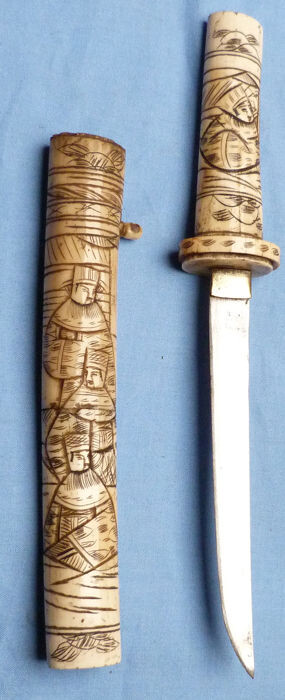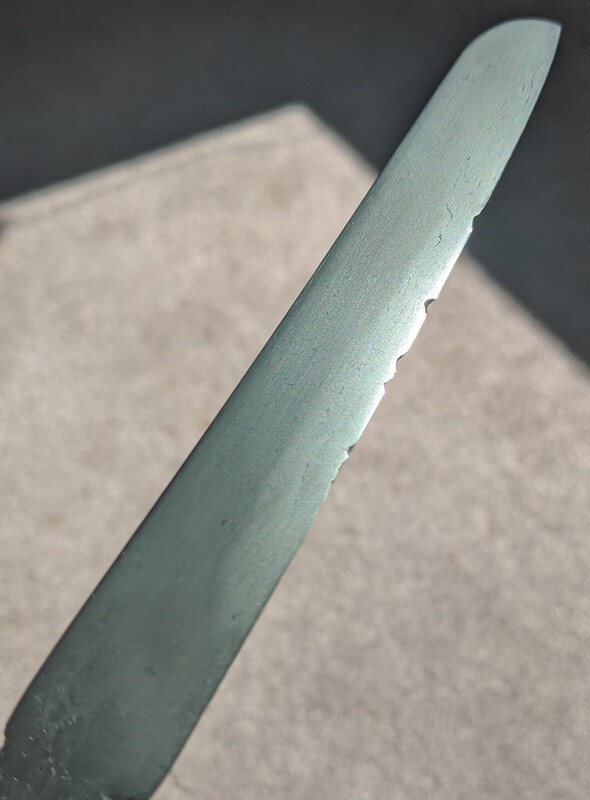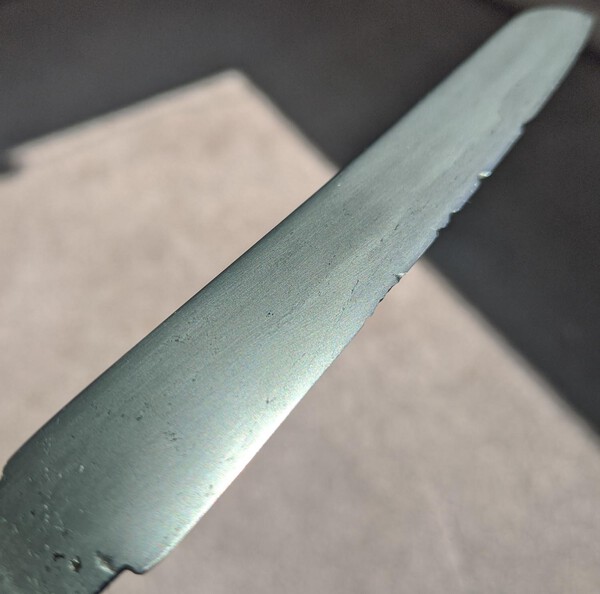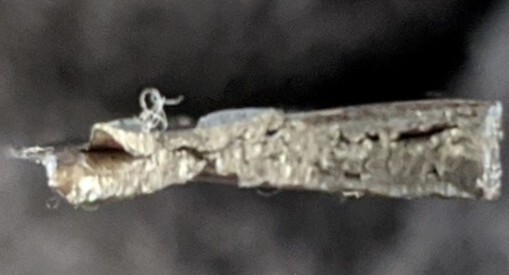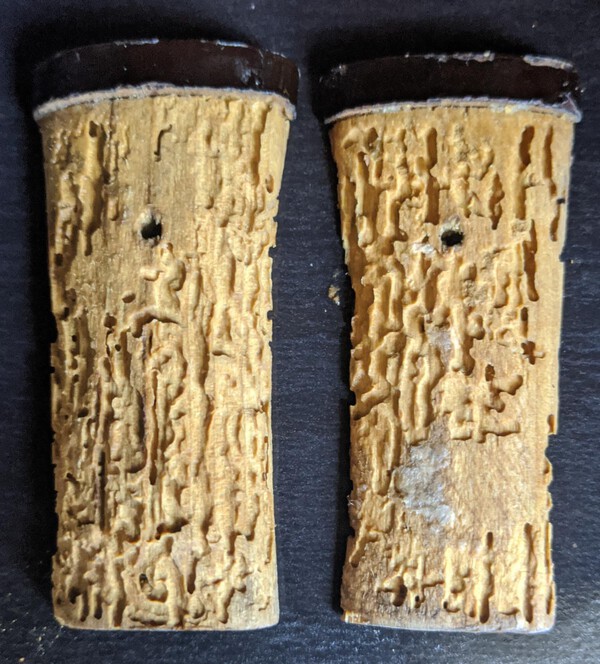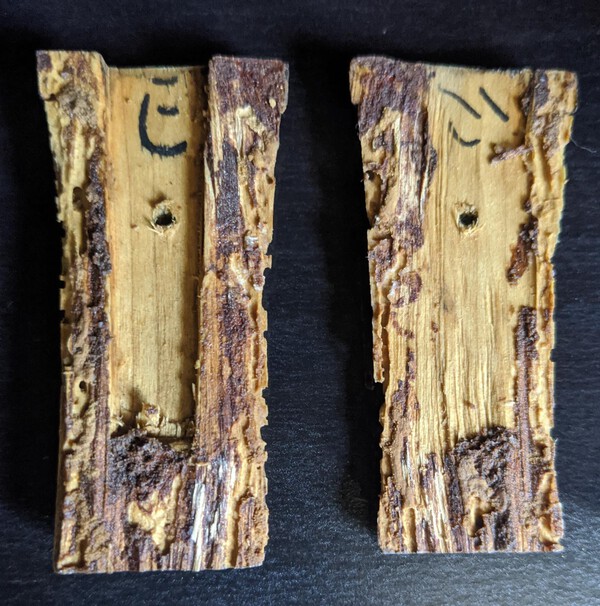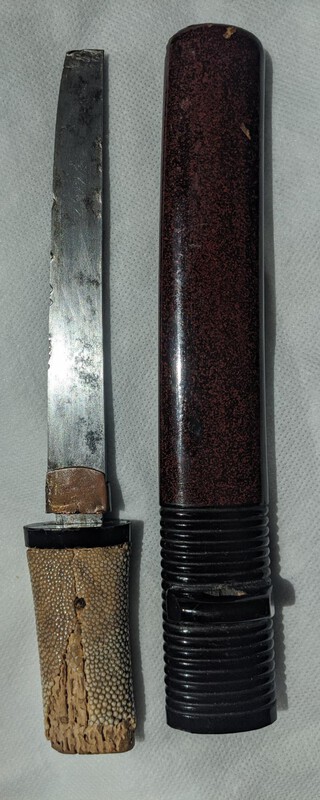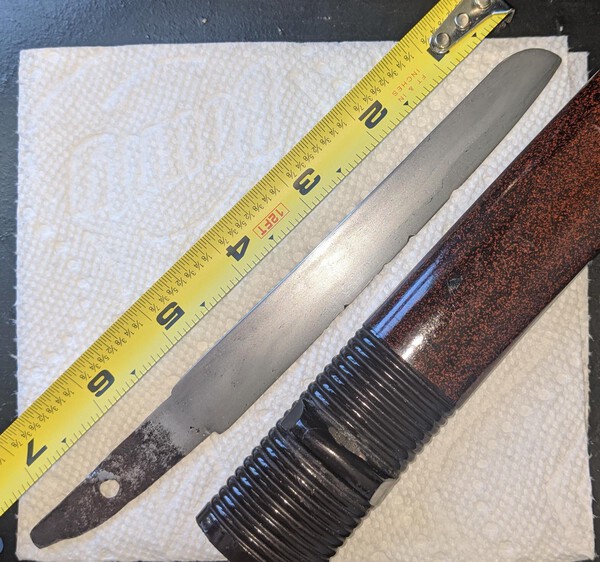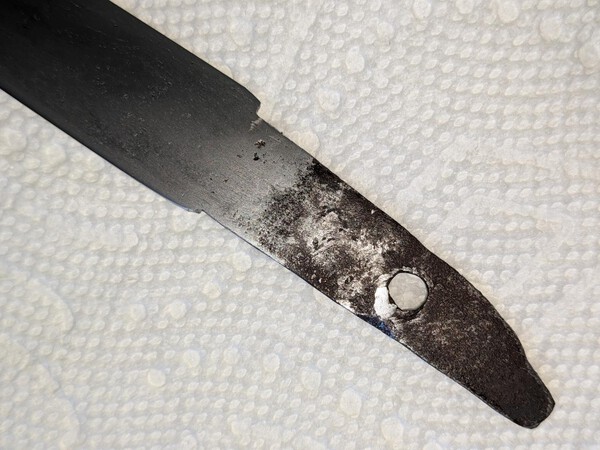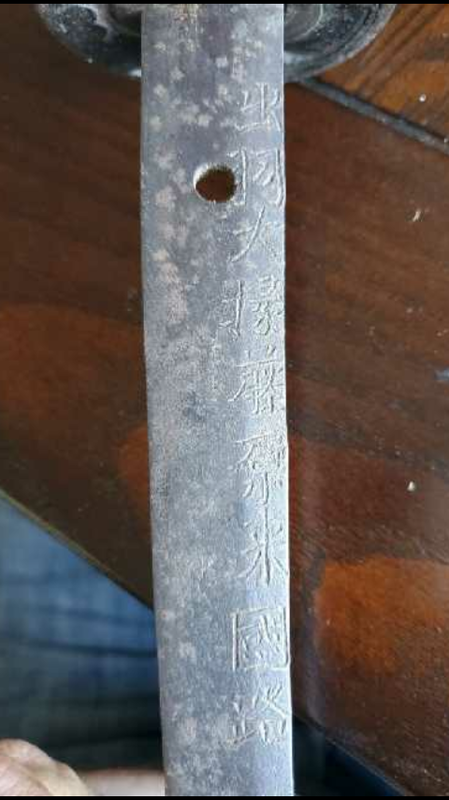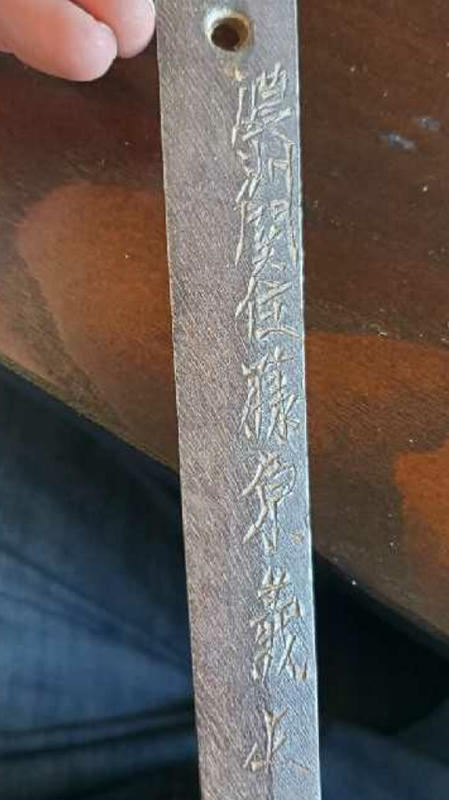-
Posts
98 -
Joined
Content Type
Profiles
Forums
Events
Store
Downloads
Gallery
Everything posted by 0Takeda0
-

Need help identifying tanto
0Takeda0 replied to 0Takeda0's topic in General Nihonto Related Discussion
The kissaki was snapped off. I showed pictures of the condition I got it in, and the break. Because I was unsure of it's value, and most of the people I've asked had assumed it was trash anyway, I took it upon myself to clean it up a little and start the satsumaage re-shaping process anyway. I figure I can't do any more damage than has already done. So far most people here have said about the same thing, that it is probably not worth trying to save, but if that is in fact the case, there is no harm in my cleaning it up myself to find out for certain. If it is worth sending to a polisher of any kind, then that's what I'll do, but I can't know until I indentify that it is at least a traditionally made blade. When I got it, I assumed there was a chance it was like one of those low-quality ww1 era tanto, i have attached an example of what I mean. -

Need help identifying tanto
0Takeda0 replied to 0Takeda0's topic in General Nihonto Related Discussion
Very true, I wouldn't have been able to see the hamon at all if it weren't for having a light directly above. Reflecting on my drawing, the hamon on the actual blade seems to be closer to the edge than on my drawing. Let me see if I can get a few better pics. I'll probably have to clean the blade's surface up some more with powder -

Need help identifying tanto
0Takeda0 replied to 0Takeda0's topic in General Nihonto Related Discussion
Regardless of how, and if the blade should be repaired, what does the hamon say about it? Even if just for the sake of knowing, I'm interested in learning be about when this blade was made. The hamon at the ha machi was hard for me to see. I did my best to meticulously trace the hamon, it's not perfect. The blade's tip broke just above where the fukura begins ( I think it probably had an o kissaki originally), meaning almost all of the original hamon is intact, except the boshi. I know it's not much to work with but I'm happy to hear anyone's thoughts on it. -

Need help identifying tanto
0Takeda0 replied to 0Takeda0's topic in General Nihonto Related Discussion
That's what I had mentioned. I had started the process of making a satsumaage kissaki myself, but didn't want to take off too much material. Just enough to see if it was worth going all the way to have a professional handle it. Not that it would of matter much. Generally, the consensus around most satsumaage blades is they are not able to be appreciated as actual nihonto, with the exception of higher quality examples or ones from famous smiths. (so, about the same in terms of value as showato). Great diagram, by the way -

Need help identifying tanto
0Takeda0 replied to 0Takeda0's topic in General Nihonto Related Discussion
Understood. How else could it have been handled? Was there any chance of saving it in the first place? Thanks -

Need help identifying tanto
0Takeda0 replied to 0Takeda0's topic in General Nihonto Related Discussion
The first two photos show the hamon on the ura side a little better. The other pictures show the cross section of where the kissaki was broken, before it was made into a satsumaage kissaki. The other two photos show the termite eaten handle, inside and out. The tsuka had been taken apart glued and back together at some point. Note the writing in the tsuka. The saya, which is still in relatively good shape, also has writing inside of it. -

Need help identifying tanto
0Takeda0 replied to 0Takeda0's topic in General Nihonto Related Discussion
Yeah... I can barely see it in person. I will provide more blade and handle pics in a bit. -

Need help identifying tanto
0Takeda0 replied to 0Takeda0's topic in General Nihonto Related Discussion
Does anyone have any guesses about the hamon? -

Need help identifying tanto
0Takeda0 replied to 0Takeda0's topic in General Nihonto Related Discussion
Both the saya and tsuka fit the blade perfectly, but I think it had a tsuba at one point. This blade is all kinds of backwards. Nothing about it makes sense to me... -

Need help identifying tanto
0Takeda0 replied to 0Takeda0's topic in General Nihonto Related Discussion
I knew the risk of polishing it, but given the state, assumed no polisher would take it, even if it was an otherwise valuable blade. I wouldn't dare take restoration of a reasonably saveable nihonto into my own hands. This one reminds me of those ww1 era tourist daggers, especially with the proportions and nakago... But I'm not completely sure -

Need help identifying tanto
0Takeda0 replied to 0Takeda0's topic in General Nihonto Related Discussion
This is what it looked like before I cleaned it up. Edit: I can't imagine what it was being used for which would have caused it to get this trashed. I'm not sure what it was originally made for -

Need help identifying tanto
0Takeda0 replied to 0Takeda0's topic in General Nihonto Related Discussion
-
I'm still getting use to using this message board, so I apologise if I do anything wrong. I am also fairly new to the nihonto community, so I don't know very much. I bought this tanto online, and I am wanting help identifying it, or determining how valuable it is. The seller claimed it was edo era. It is very short and thin. It is mumei, but looks like there may have been some kind of markings at one point. I didn't spend too much on it, as it was in really bad shape. I received it with the tip broken off completely, with several chips. As far as the koshirae goes, the saya was in ok shape. The habaki was cracked and scratched from what looks like someone removing the handle recklessly. The tsuka had been repaired before, and had since been eaten by termites. The stingray skin wrap was put on backwards. The kashira was missing, and the fuchi was carved out of the handle to look like horn, but is all really one solid piece. Given the state of the knife, I felt comfortable giving it a little bit of polishing, just enough to see what I think is the hamon. I can only really see what I think is the hamon on the ura side, but I'm not wanting to remove too much material, in case it is worth sending to a polisher. I cleaned up the tip and re-shaped it. Any help would be appreciated
-
What is a Kanagu exactly?, Google images pulls of a type of hardware between a kurikata amd kojiri, which I have seen before on taisho era sword. Sagurigane seems to be what pulls up pictures of what I'm describing after reading the other posts
-
I am relatively new to this platform, please forgive me if I do something wrong I have questions about a few different things, but I don't think they deserve their own topic seperately. Here are my questions: What are sheath menuki called? menuki and other unsusual hardware on sheaths is mostly something i see on emishi, ainu and mainland asian swords. On google images I've seen two shoto, and one daito, with what looks like a normal sized menuki on the sheath. On emishi swords, menuki on the handle and saya are very big ususally. Im bot referring to a larger kojiri or kaeri tsuno, it is usually placed in between them on the saya (I dont know if there is only one on the omote usually or if it is on both sides) I also see a lot of rings on emishi swords. Like one you might see on a jokoto era swords and old tachi from both Japan and Korea, to attach a tenuki tassel to. But instead of just one, several of them in a row. This brings me to my last questions On old tachi, especially those without ito or with a stingray only wrap, one might see several small ornaments in a row, not centered. Thanks!
-

Help translate and Identify nakago on Showato
0Takeda0 replied to 0Takeda0's topic in Military Swords of Japan
I don't have any new pictures,but i was wondering what kind of gunto koshirae it was. It has a few unique features. Waxed looking black ito, and a tenuki/tassel ring made of ito or cloth. Also a blank wood saya with a leather cover. I presume it is some kind of civilian mounts -

Help translate and Identify nakago on Showato
0Takeda0 replied to 0Takeda0's topic in Military Swords of Japan
I might get blade pics tomorrow -

Help translate and Identify nakago on Showato
0Takeda0 replied to 0Takeda0's topic in Military Swords of Japan
The first gimei is priced at just under $3000 usd, is it a rip-off? -

Help translate and Identify nakago on Showato
0Takeda0 replied to 0Takeda0's topic in Military Swords of Japan
Just compared the first mei with others online, I agree its is fake, thanks -

Help translate and Identify nakago on Showato
0Takeda0 replied to 0Takeda0's topic in Military Swords of Japan
I compared the first signature to another blade by the same maker sold on aoi just now. Im sure it's fake. Different hamon too -

Help translate and Identify nakago on Showato
0Takeda0 replied to 0Takeda0's topic in Military Swords of Japan
Do you know what the second one says too by any chance? Thanks by the way. -
I am very new to using this message board, so please forgive me if I do something wrong. I was told this blade was stamped, cant tell or see in pics. Something im considering buying as a first sword before something more valuable. It is unique, as the mounts seem like civilian mounts, leather sheath, tenuki ring is beige ish yellow cloth unlike most gunto, not generic tachi fittings on handle. Here are nakago pics. I am aware that there are two different nakago, i dont remember which one is the right one.


